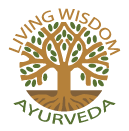
Living Wisdom Ayurveda is dedicated to Empowering You To Heal Yourself through offering herbal remedies, home therapies and tools for healing from both the Indian and alternative western systems of health.
The Pitta dosha is primarily composed of the fire element. Intuitively, we know if someone describes another as firey, we would envision a person who is passionate, willful, courageous, ambitious, intelligent and a natural leader, but with a possible tendency to be dominating, critical, controlling, vengeful and prone to anger and pride. They tend to burn themselves and others out through driving over-achievement and unrealistic perfectionism.
Pitta qualities are hot, light, oily, sharp and mobile. The Pitta energies rule the liver, small intestine, blood, vision, digestion, metabolic activity and the levels of heat throughout the body. Those with a primarily Pitta dosha often succumb to conditions such as liver and blood diseases, heat or fever conditions, inflammations, infections, thirst, yellow tones of the tissues, hunger, eye problems, skin rashes and ulcers.
FOODS FOR PITTA:
Foods that are recommended for Pitta conditions would ideally balance their hot, sharp & pungent nature. They, therefore, require a simple cool, no- oily and slightly heavy diet which includes sweet, bitter and astringent tastes. They should reduce the sour, salty and pungent tastes which aggravate their fire, as do caffeine and alcohol, which should be avoided. Raw foods and juices are great, as are whole grains, vegetables, beans & seeds.
Pitta conditions will get the most enjoyment out of food when eaten slowly with attention to chewing well and being present with the tastes being experienced, without thinking of the next bite. A calm attitude is important as they may even forget that they are actually eating if their mind is pulled towards the TV, their work, or a conversation. Pitta conditions should avoid eating when upset as they will end up eating those negative emotions and making the situation worse. Cultivating an attitude of thankfulness for the meal without a critical eye, and taking a pause before eating to reflect upon all those who do not have food, will all promote contentedness, humility and gratitude which are helpful for balancing Pitta’s energies.
Regular meals are good for the Pitta condition’s strong digestion and when this is not possible, high-protein snacks should be enjoyed, rather than pushing oneself through hunger. Eating late in the evening past 6 pm should be avoided as this stagnates the liver (the seat of Pitta energies). If unavoidable, eat only a light meal with no oils or heavy proteins.
Fruits for the Pitta include sweet apples, blueberries, dates, figs, grapes, limes, melons, sweet oranges, pears, persimmons, pineapple, plums, pomegranate, prunes and raspberries. Mangos, apricots, peaches, cherries, grapefruit, papaya and strawberries should be reduced.
Vegetables are beneficial for the Pitta condition, especially when steamed, or prepared and not fried. It is recommended that Pitta conditions avoid vegetables from the nightshade family of tomatoes, potatoes, eggplant, peppers, chillies, as well as chard, spinach, beets, carrots, onions, radish, turnips, watercress.
Whole grains are necessary for the fast Pitta metabolism, although buckwheat, corn and rye are slightly more heating.
Beans of all types are beneficial, except lentils.
Nuts and seeds are generally heated and are better consumed raw or soaked, and should be avoided when salted or roasted. However, Pitta conditions do need high protein diets and nuts and seeds are less aggravating than meats.
Oils are to be used minimally, with the best option being coconut, sunflower, soy, canola, almond, ghee and butter.
Dairy is a good source of protein & calming calcium for Pitta conditions, however, they should avoid soured/salted dairy products. A particularly high Pitta condition may actually curdle milk and, in this case, should avoid it.
Sweeteners are cooling & calming for Pitta conditions, but moderate use is suggested, but white sugars, old honey and molasses should be avoided.
Herbs and spices for Pitta conditions include
Digestion – Digestives with meals such as rosemary, mint, fennel, coriander, turmeric, saffron, dill, cumin, and cardamom. For an overly strong appetite which burns too quickly our NEEM and LIVER AID formula is ideal to take before meals.
Elimination – Pittas rarely get constipated, but if they do, elimination is supported by aloe, rose, milk, rhubarb root, psyllium and TRIPHALA. If there is chronic loose stool NEEM or LIVER AID is recommended.
Tonics – Pitta balancing tonics for deep nourishment include bala, shatavari, amalaki, saffron, aloe, gadduchi, licorice, dandelion root, burdock root and the tri-doshic STRENGTH formula.
Mind herbs – The mind can be dominating in Pitta conditions and ideal herbs are brahmi, gotu kola, bhringaraj, sandalwood, rose, hops, passionflower, lotus and our tri-doshic blend STRENGTH. Pitta conditions should particularly avoid asafetida, black pepper, cayenne, garlic, horseradish, oregano and mustard.
Herbal teas that are soothing for Pitta conditions include liquorice (not for those with high blood pressure ), alfalfa, chamomile, dandelion, burdock, fennel, anise, hawthorn berries, lavender, horsetail, jasmine, rose petals, gota kola, lemon balm, lotus, mint, passionflower, red clover, red raspberry, safflower and slippery elm.
THERAPEUTIC RECOMMENDATIONS:
Pitta conditions need early nights and to be asleep by 10 pm in order to support and rejuvenate the liver, which is the seat of the Pitta dosha. Waking up early, rather than staying up and going to bed late, will allow Pitta types to make up for any unfinished projects that they might have. This is surprisingly effective for liver/blood/skin health. Pitta conditions should avoid wild places and direct exposure to the sun. Moon bathing is encouraged.
As Pittas like to be busy, enjoying time alone is important. Time in nature, gentle reading, and watching inspiring yet calming movies (not the action-packed ones which just aggravate the Pitta fire) are encouraged. Pitta conditions can balance their fire by moderating strenuous activities and including some more gentle forms of exercise, such as swimming or taking a slow walk.
Simple Hatha yoga postures, particularly lying & sitting postures are good, along with forward bends, plough & shoulder stand. Practice is best in a cool/ ventilated space with gentle music, holding the postures for longer and breathing deeply into the stretch. Relaxing & enjoying each pose before moving on to the next thing is an important attitude to cultivate which balances the Pitta condition’s competitive nature. A solo practice also strengthens this peaceful mindfulness. It is recommended that you always finish with an extended Shavasana, thus integrating the practice. Pranayama practices should include alternate nostril breathing, or the shitali mouth breathing to cool the system. If Pitta is aggravated, try breathing the lunar breath through the left nostril to cool the system.
Meditations which promote surrender & opening the heart are ideal. Affirmations that cultivate forgiveness are recommended for Pitta conditions – both bestowing this to others and being humble to ask for forgiveness for harms they may have perpetrated. Praying for those less fortunate is also highly beneficial. Allow the mind to drop into the heart when meditating because this helps judgmental thoughts to be observed from a deeper place within, allowing the story to be dropped.
Colours which best balance Pitta fire are greens and blues. Fabrics need to be natural to allow the body to be cool and breathe with loose-fitting styles.
It is important to honour the incredible beauty of Pitta’s fire when it is in balance. Allow these simple practices & observations to cultivate the positive side of Pitta, which is its courage, warmth and friendliness, its straightforward clarity, its perceptive insight and its ability to inspire others in a positive way.


Living Wisdom Ayurveda is dedicated to Empowering You To Heal Yourself through offering herbal remedies, home therapies and tools for healing from both the Indian and alternative western systems of health.
© Living Wisdom Ayurveda, Koh Phangan 2023
Design & Development by Webheadz Media